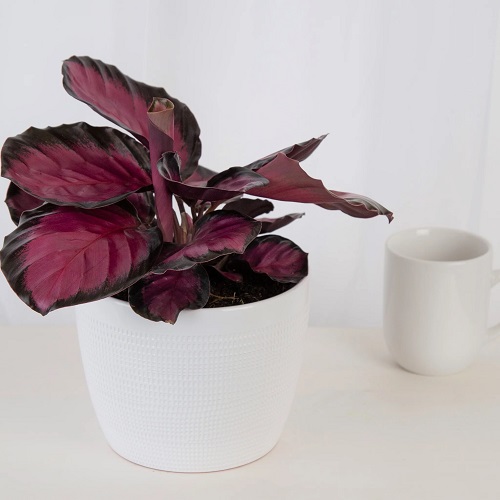Liven the dull corners of your home with the vibrant foliage of the Pink Star Calathea! Here’s an extensive care guide to help you!

Native to the tropical Americas, Calathea Pink Star is prized for its vibrant pink and green foliage. Popular as Pink Prayer Plants, the plant got its nickname—Prayer Plant, due to its fascinating nyctinastic behavior, which involves the opening and closing of its leaves in response to light. During the day, the leaves of Calatheas spread out to capture sunlight, while at night, they fold upwards like hands coming together in prayer. Bring home this vibrant houseplant with the help of our extensive care guide!
- Popular as—Pink Star Calathea, Calathea Pink Star, Pink Prayer Plant
- Reaches a height of 12-18 inches
- Prized for broad, dark pink foliage
- Thrives in a temperature range of 65-85°F (18-29°C)
- Loves high humidity
- Non-toxic to pets
Learn about Growing Red Sister Plants Indoors here
Calathea Pink Star Plant Profile
Member of the Marantaceae family, Calathea Pink Star is a stunning tropical plant known for its eye-catching foliage. Its large, oval-shaped leaves display intricate patterns with a mix of dark and light green edges, creating a striking contrast. The plant’s namesake, ‘Pink Star,’ comes from the delicate pink to purple hues that adorn the central rib of each leaf, adding a touch of elegance to its appearance.
As the plant matures, the leaves grow on tall, slender stems, creating an attractive, bushy appearance and a compact size of about 12-18 inches. The unique combination of colors and patterns makes the Calathea Pink Star a popular choice for interior plant enthusiasts seeking a visually striking addition to their collection.
Ideal Pot Size
The ideal pot size for a Calathea Pink Star can vary depending on the size of the plant’s root ball and how quickly you want it to grow. Generally, a 6-8 inches pot is suitable for a small to medium-sized plant. It’s important to choose a pot with drainage holes to prevent water from accumulating at the bottom, which can lead to root rot.
You may upgrade the plant to a bigger size container once you find the roots coming out of the drainage holes.
Propagating Pink Prayer Plant Indoors

Pink Star Calathea can be propagated through stem cuttings or root division. Here are the steps for each method:
Propagation via Stem Cutting
- Select a mature, robust stem from a disease-free, healthy parent plant.
- Cut the stem just below a node using a sharp, sterile clipper.
- Remove the lower leaves from the cutting, leaving only a few at the top.
- Dip the cut end of the stem in rooting hormone powder, shaking off any excess.
- Prepare a pot with a well-draining potting mix and plant the cutting into it.
- Water the medium and place it in a warm, bright location with indirect sunlight.
Keep the soil moist but not waterlogged, and mist the cutting regularly to maintain humidity. After a few weeks, the cutting will develop roots and new growth. Once it has established roots, it can be transplanted into a larger pot.
Propagation via Root Division
- Remove the parent plant from its pot and gently divide the root ball into smaller sections.
- Choose a section with a healthy root system and plant it in a well-draining potting mix.
- Water the new plant and place it in a warm, bright location with indirect sunlight.
- Keep the soil moist but not waterlogged, and mist the plant regularly to maintain humidity.
After a few weeks, the new plant should begin to grow and develop new leaves.
Requirements for Growing Pink Prayer Plant

Light
The Pink Star Calathea thrives in medium to bright indirect light, making it an ideal houseplant for indoor spaces. However, direct sunlight can scorch its delicate leaves, stealing their vibrant coloration and patterns. Maintain a consistent light source to promote healthy growth and prevent leggy, stretched-out foliage.
A north or East facing window can be the plant’s happy place with a few hours of bright morning sunlight. If you have limited natural light, expose the plant to fluorescent lights to enjoy the vibrant display of foliage.
Soil
The Calathea ‘Pink Star’ requires well-draining soil that retains some moisture but doesn’t remain soggy. Combine equal parts of peat moss or coco coir, perlite, and a fistful of compost or aged bark to provide the ideal balance of drainage, aeration, and nutrients. Maintain a slightly acidic pH between 6.0 and 6.5.
You can further improve drainage by placing a layer of pebbles, broken pottery, or other coarse material at the bottom of the pot to prevent waterlogging.
Water
This Pink Prayer Plant requires consistent moisture but is sensitive to overwatering, so it’s best to keep the soil slightly damp but not waterlogged. Water the plant thoroughly when the top 1-2 inches of soil feel dry to the touch, using room-temperature water. Ensure that excess water drains from the pot and does not pool near the roots.
During the growing season, which typically runs from spring to fall, the plant may need to be watered more frequently, perhaps once a week or so. In the winter, when the plant is dormant, you can cut back on watering and allow the soil to dry out a bit more between waterings.
Keep an eye on the top layer of the medium and do the needful.
Temperature & Humidity
As a tropical plant, Calathea Pink Star prefers warm temperatures for optimal growth. The ideal temperature range is between 65-85°F (18-29°C). Avoid placing the plant near drafts, air vents, or cold windows, as temperature fluctuations can stress the plant and cause leaf curling.
Temperatures below 50°F (10°C) can cause permanent damage to the foliage; consider using a space heater or a heat mat to maintain if the degrees fall below the point.
This ornamental Pink Prayer Plant loves high humidity levels, similar to its native place. Maintain a humidity level of 50-60% or higher. Use a tray filled with water and pebbles, place a humidifier near the plant, or group it with other humidity-loving plants to boost moisture in the atmosphere. Regular misting with distilled or filtered water can also helps.
Pink Star Calathea Care

Fertilizer
Pink Star Calathea does not require frequent fertilization. In fact, over-fertilization can cause damage to the plant. A balanced fertilizer with equal parts of nitrogen, phosphorus, and potassium is ideal for maintaining the plant’s beauty. Dilute the blend to half its strength and spray the plant every 4-6 weeks in the spring and summer.
Always fertilizer to moist soil, as this will help prevent the burning of the plant’s roots. If you prefer organic fertilizers, consider using compost or worm castings. Side-dress the plant with these natural fertilizers to provide a slow release of nutrients over time.
Do not feed the plant during its dormancy in winter to prevent salt burn in the medium.
Pests and Diseases
Calathea Pink Star can be susceptible to common houseplant pests such as spider mites, mealybugs, and aphids. Inspect the plant regularly for any signs of infestation, and treat promptly with insecticidal soap or neem oil solution. You may also clean the glossy leaves with a cotton pad dipped in rubbing alcohol to wipe away any cotton patches on the undersides of the leaves.
Overwatering and poor drainage can lead to root rot, while low humidity may cause leaf-tip browning. To prevent diseases, provide proper ventilation and regularly remove dead or damaged leaves.






